 |
 |
 |
| |
Eltrombopag, an Oral Platelet Growth Factor, Facilitates Initiation of Interferon Therapy in Subjects with HCV Associated Thrombocytopenia
|
| |
| |
Results from a Phase II Placebo Controlled, Double-Blind, Dose-Ranging Study
McHutchison JG; Afdhal NH; Dusheiko G; Shiffman ML; Rodriguez-Torres M; Sigal S; Bourliere M; Berg T; Blackman N; Campbell FM; Theodore D.
BACKGROUND
Thrombocytopenia frequently accompanies advanced chronic liver disease.
In chronic liver disease patients with low platelets, many procedures are required:
Liver biopsy
Paracentesis
Line insertion
TIPS
Dental extraction
Surgery/transplantation
Patients with more advanced liver disease due to chronic hepatitis C complicated by thrombocytopenia may not be candidates for anti-viral therapy.
AUTHOR CONCLUSION
Eltrombopag increased platelet counts in subjects in all dose groups
A significant number of subjects achieved the primary endpoint (Week 4) in all dose groups compared to placebo
Eltrombopag enabled 45/56 subjects to initiate IFN therapy
--31 subjects completed 12 weeks of IFN therapy
Preliminary PK findings in general indicate exposure increases with dose with wide variability
No safety signals of concern in this initial short term study
Safety and efficacy data supports further investigation of eltrombopag in this patient population
Eltrombopag
Oral Small Molecule Platelet Growth Factor
Small molecule thrombopoeitin receptor (TPO-R) agonist (mw=442)
Orally bioavailable
Interacts with TPO-R differently than endogenous TPO
Stimulates megakaryocyte proliferation and differentiation
Does not prime platelets for activation
Increases platelet counts in humans
eltrombopag (SB 497115) is a novel, first in class, oral small molecule platelet growth factor
In preclinical and clinical studies eltrombopag has been shown to stimulate megakaryocyte differentiation and proliferation and increases platelet counts in chimpanzees and humans in a dose dependent manner.
As a small molecule, eltrombopag has lower immunogenic potential, an issue for peptidyl drugs.
Ex vivo experiments with human platelets and in vivo studies in healthy volunteer studies have demonstrated that eltrombopag does not prime platelets for activation and does not adversely affect platelet function.
Rationale For Study
Thrombocytopenia associated with chronic HCV infection may prevent initiation and continuation of therapy with pegylated IFN and ribavirin
-- TPO-R agonists may have role in initiation and maintenance of IFN based therapy
Study designed to:
-- Assess use of eltrombopag to facilitate initiation and maintenance of pegylated IFN based antiviral therapy
-- Assess safety and tolerability
-- Assess population PK profile
Eligibility Criteria
Male or female ≥18 years of age
Chronic HCV infection
Prior liver biopsy indicating chronic hepatitis or
Radiographic evidence of cirrhosis or
Non bleeding gastro esophageal varices
No ascites
Compensated liver disease
Pre-existing thrombocytopenia: 20,000-70,000/⊥
No history of thrombosis, HIV infection, active hepatitis B virus infection
Study Design
A Randomized Double Blinded Ph II Study
Initially patients recd for 4 weeks, placebo or 1 of 3 eltrombopag doses (30, 50 ot 75 mg). Then if platelets were >70,00 for Pegasys or >100,000 for PegIntron pegIFN/RBV therapy was started along with eltrombopag for 12 weeks. Then there was a 4 week followup period.
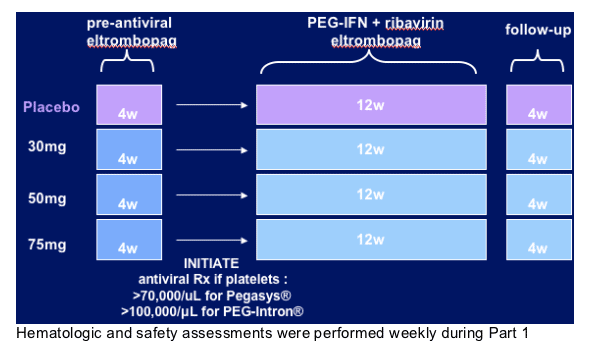
RESULTS
Data are presented from analysis of 74 subjects randomised
Primary efficacy endpoint
-- Proportion of subjects with platelet count ≥100,000/⊥ after 4 weeks of eltrombopag/placebo
Secondary endpoints including antiviral outcomes in maintenance phase
Safety and tolerability
PK/PD relationship
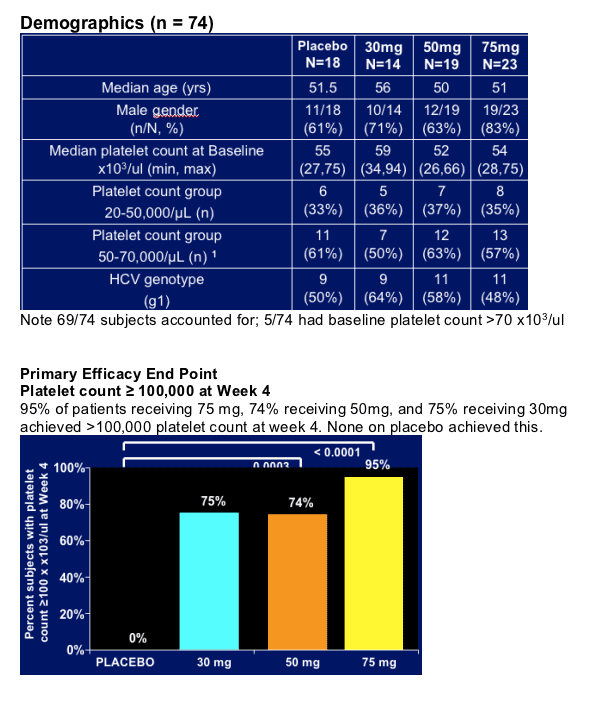
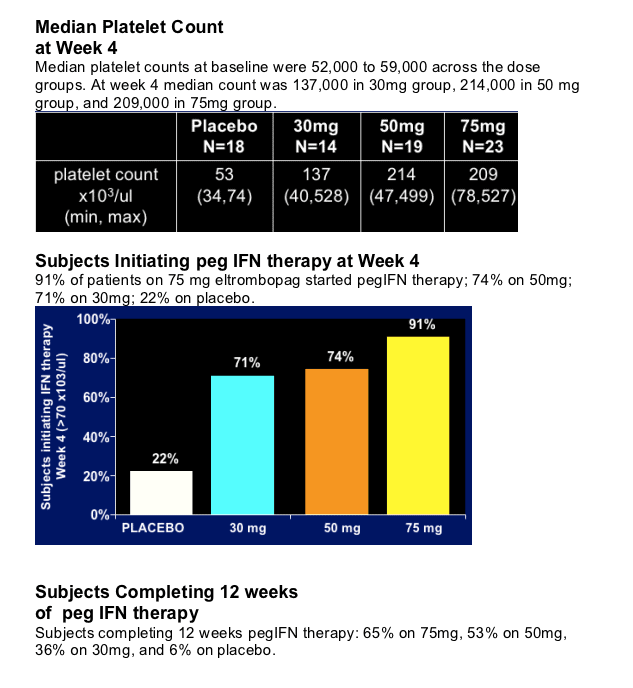
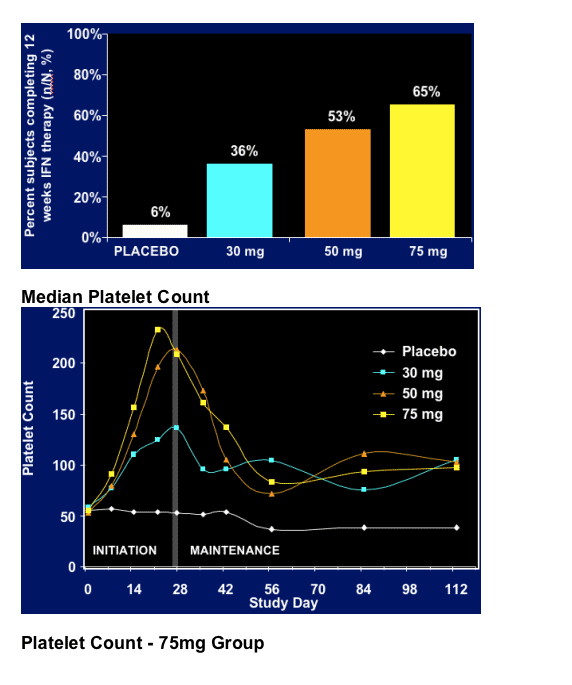
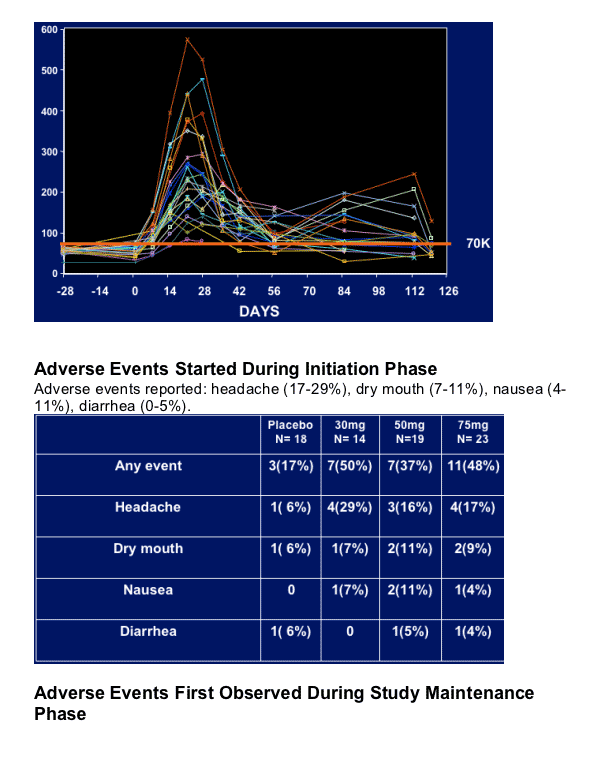
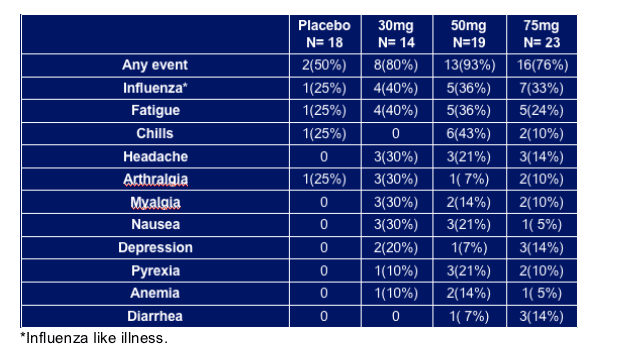
AEs Leading to Withdrawal
5 subjects had AEs leading to withdrawal
AEs leading to withdrawal during Initiation
-- Abdominal pain (30 mg), Moderate
AEs leading to withdrawal during Maintenance
-- Thrombocytopenia (30mg), Severe
-- Ascites (30mg), Severe
-- Neutropenia (50 mg), Grade N/A
-- Retinal exudates (75mg), Severe
Serious AEs
Subjects with SAEs started during treatment
-- Ascites (30 mg)
-- Retinal exudates (75 mg)
Subjects with SAEs started after treatment stopped
-- Abdominal pain (placebo)
-- Renal failure (placebo)
same placebo subject reported both SAEs above
--Thrombocytopenia (30 mg)
-- Myositis (50 mg)
Ongoing safety monitoring
Ongoing Safety Monitoring
Results presented are from all subjects including 4-week off treatment follow-up (end maintenance phase)
6-month safety and ocular follow-up data currently being collected
-- last subject visit end Oct 06
-- analysis ongoing
2 new SAE's reported and being followed-up
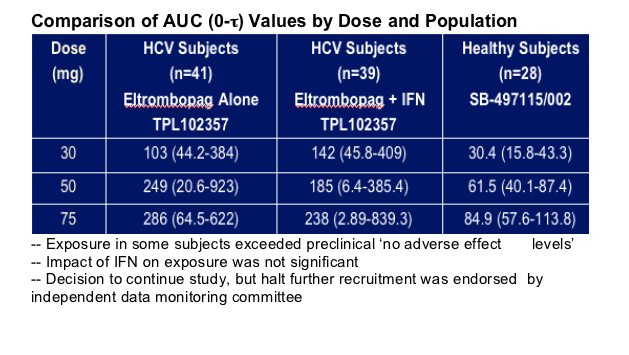
|
| |
|
 |
 |
|
|